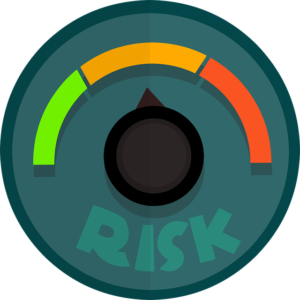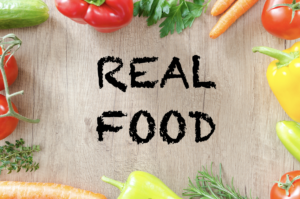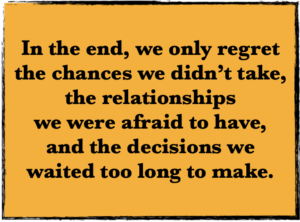 Are you a risk-taker?
Are you a risk-taker?
Now, we are NOT talking about bungee jumping or James Bond 007 stunts where your life’s in danger…just basic risk-taking.
Whether we realize it or not, we all take risks every day. We also make decisions NOT to take certain risks.
What is risk?
Risk causes a lot of people anxiety, because we often think about risk as “a situation involving exposure to danger” or “the possibility that something unpleasant or unwelcome will happen.” So, driving 30 mph over the speed limit greatly increases your likelihood of an accident or the unfortunate pleasure of seeing the heart-dropping red and blue lights in your rearview mirror!
 But of course, we don’t make decisions based only on the risk…there’s the “what’s in it for me?” benefit too. We consider the potential benefits (“a good or helpful result or outcome”) to be what we get in return for taking the risk. And, we know that reward and risk are inseparable — it’s all about the tradeoffs between the benefits and the risks.
But of course, we don’t make decisions based only on the risk…there’s the “what’s in it for me?” benefit too. We consider the potential benefits (“a good or helpful result or outcome”) to be what we get in return for taking the risk. And, we know that reward and risk are inseparable — it’s all about the tradeoffs between the benefits and the risks.
The benefit of flying 30 mph over the speed limit? We will get to our destination faster, which may mean we will be on-time for work or that important appointment. For most of us, though, this benefit may not be significant enough (maybe it only justifies 10 mph over the speed limit…not 30)!
What kind of risks do we encounter?
“No-brainer” risk:
The benefit is significantly greater than the risk! Telling your spouse “I love you” or hugging your kids as they head out the door…we can’t argue that these actions have enormous benefit and NO risk. Eating together as a family? Again, most of us would agree there is significant benefit and NO risk (unless an unexpected sibling food fight breaks out). Hopefully, we all take these “no-brainer” risks A LOT!
“Playing with fire” risk:
 The risk is greater than the benefit! Many of us decide not to smoke, use drugs, or skydive because we believe the risk of injury or illness far outweighs the benefits. We believe the risk is “just not worth it.”
The risk is greater than the benefit! Many of us decide not to smoke, use drugs, or skydive because we believe the risk of injury or illness far outweighs the benefits. We believe the risk is “just not worth it.”
“State of denial” risk:
These are the “it won’t happen to me” risks! Texting and driving – or speeding – are prime examples. We have heard so many stories of lives ending prematurely because of texting and driving, yet many people still do it. Why?
Is it because they think the benefit is greater than the risk? Most of us would agree the benefit isn’t great enough, but many still do it because they think “that accident won’t happen to me” or “just this one time…nothing will happen and I will never do it again”…until the next time, of course. These “state of denial” risks may later turn into ones we strongly regret.
By now you are probably wondering…what does this have to do with REAL food?
 We recently listened to an interview with a doctor who had done some clinical trials to try to understand how certain foods affect the risk of cancer and other chronic diseases such as diabetes and heart disease. His trials and other research are part of the growing body of evidence that what we eat has a significant influence on our risk of getting these diseases.
We recently listened to an interview with a doctor who had done some clinical trials to try to understand how certain foods affect the risk of cancer and other chronic diseases such as diabetes and heart disease. His trials and other research are part of the growing body of evidence that what we eat has a significant influence on our risk of getting these diseases.
When he described the benefits of a diet based on REAL food, the interviewer asked:
“what’s the downside?” and the doctor responded “there isn’t one.”
The interviewer then said,
“So let me see if I understand you. I can do something that’s good for me, that tastes good, that feels good to do, and makes me feel better.
Where’s the downside? I’m waiting for the hook here.”
Did you catch that?!
THERE ISN’T ONE!
A diet based on REAL food…there isn’t a downside!
So, here’s our question…what are the risks and benefits of eating REAL food vs. eating “convenience” and highly-processed foods?
Regularly consuming highly-processed foods would fit into the “state of denial” category. We know it’s not good for our health, leads to weight gain, and increases the risk of diseases like diabetes, heart disease, kidney disease, cancer and others, but we still do it!
The benefits? Perhaps it’s convenience, less arguing with our picky eaters, or the taste we are accustomed to. Are these benefits really that much greater than the risk? Maybe in the short term, but many would say “no” over the long-run.
So, why is highly-processed food the preferred choice? Similar to texting and driving, it sounds like a state of denial thinking…“that disease or illness will never happen to me” or “just this one time, and then I will get my eating on track”…until the next meal, of course. Again, this type of risk-taking is one that we may later strongly regret.
 Regularly eating REAL food, on the other hand, fits perfectly into the “no-brainer” risk category. The benefits? Decreased risk of chronic disease, great taste, weight loss for many, increased energy, and many more. And, with a little planning, these foods really can be just as convenient as a frozen pizza, carry-out, or a box of mac & cheese. And, the risks?
Regularly eating REAL food, on the other hand, fits perfectly into the “no-brainer” risk category. The benefits? Decreased risk of chronic disease, great taste, weight loss for many, increased energy, and many more. And, with a little planning, these foods really can be just as convenient as a frozen pizza, carry-out, or a box of mac & cheese. And, the risks?
As the doctor said, “there isn’t one.”
 LEARN MORE ABOUT THE NAPKIN!
LEARN MORE ABOUT THE NAPKIN!

That is so true, “there isn’t one” I love it, I hope that others will see the benefit of Eating Real!
It is crazy that there is no downside to eating REAL! Thank you for the feedback and your ongoing support!